Lockheed Martin started building its latest civilian version of the iconic C-130 Hercules in Marietta, Georgia earlier this week. The company's new LM-100J will bring the advancements of the C-130J Super Hercules to civilian operators such as the United Nations.
The C-130 just never dies. Why? Because almost no other aircraft can do what the Herc does best: reliably haul outsized loads into and out of short, rough airstrips in the middle of nowhere.
"They obviously did its design right," says Tom Wetherall, director of LM-100J Business Development for Lockheed Martin. "It's been in production for 60 years. It's got a high-wing. It's a turboprop. The engines and propellers are out of harm's way... The straight wing yields the efficiency to get in and out of dirt runways, to get the weight off the wheels as soon as possible. The fuselage is low to the ground at truck-bed height, which combines with the rear loading capability. It's a configuration that's second to none."
The first C-130 rolled out in 1954. Since then, Lockheed has built more than 2,500 at its Georgia assembly plant. More than ten variants of the airplane, including AC-130 gunships and WC-130 weather reconnaissance aircraft, serve U.S. and global militaries.
In 1965 Lockheed started making a dedicated civilian version of the Hercules, the L-100, cranked them out until1992. About 115 L-100s have flown with commercial operators, delivering spare parts and bringing in disaster relief. But these old planes are nearing the end of their useful lives, and the companies that fly them are a looking for a new airplane—a new Hercules, according to Lockheed.
The LM-100J is based on the C-130J-30, an extended version of the "J" that shares the same length as the L-100. Like the military Super Hercules, the LM-100J gets new Rolls-Royce AE 2100 D3 turboprop engines and six-blade Dowty R391 propellers. The airframe features a new center wing-box. The cockpit comes with Full Authority Digital Engine Control (FADEC) which eliminates the need for a flight engineer, a significant cost savings.
The new engines and props yield a 24 percent increase in thrust and 15 percent increase in fuel efficiency. Whereas an L-100 could fly 1,800 nautical miles (NM) with a 35,000-lb. cargo load, an LM-100J will haul the same load 1,000 NM further. Lockheed says the added range allows LM-100J operators to plan more route segments in a given day since less fuel consumption allows for more stops or offloading in places where no gas is available. The latter is particularly attractive to companies that fulfill UN contracts in Africa, which stipulate day flying only to remote areas.
Cockpit systems like a primary heads-up display for the pilot add to the LM-100J's utility as well. "We think pilots will appreciate having that heads-up situational awareness in the takeoff and landing environment," Wetherall says.
And because it's essentially a C-130, the LM-100J can get support just about anywhere. The new plane has about 80 percent of its parts in common with the legacy C-130H or L-100. About 95 percent of ground support equipment is common between the C-130J and the LM-100J.
Lockheed Martin plans to roll out the first LM-100J this September. Flight testing begins early next year and the first delivery is slated for the first quarter of 2018. When LM-100Js do go into service, they'll enjoy another advantage—people the world-over recognize a C-130. "A lot of the L-100 work continues to be for the United Nations," Wetherall says. "The LM-100J will take over that workload. When people see a C-130 painted white with 'U.N.' on the tail, it means help, it means relief. We're proud that the LM-100J will enjoy that same public recognition."















